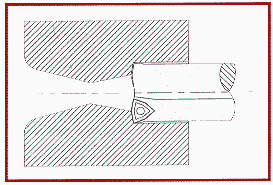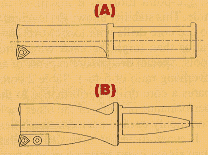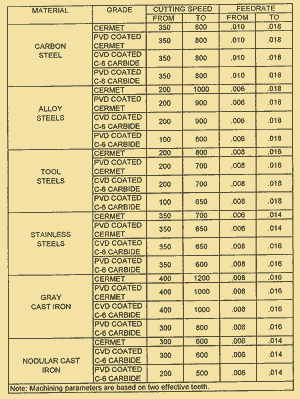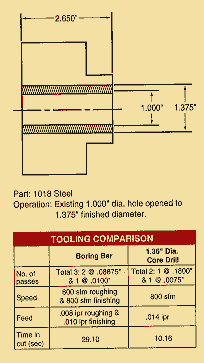A core drill’s two cutting edges give it an advantage over the single-point tools that machinists typically use to open existing holes.
Until recently, machinists couldn’t use the right tool to open an existing hole, because no such tool existed. The tools they used were adequate for cutting into the walls of holes that had been cast, punched, or drilled into the workpiece, but they weren’t ideal. They didn’t have the stability to cut deeper holes or the convenience of an indexable-insert design. It wasn’t until the introduction of the 2-flute indexable core drill that machinists had a tool specifically designed for the job.
Parts with existing through or blind holes frequently need machining to straighten the holes, improve their circularity and cylindricity, smooth their inner walls, and enlarge their diameters to a specified dimension. Over the years, machinists have tried using brazed single-point turning tools, indexable drills, and single-point boring bars to perform these tasks. Many have switched to indexable-insert core drills because the new tools cut more accurately and are easier and less expensive to maintain. These machinists are using core drills in rotating applications on milling machines and machining centers and nonrotating applications on lathes.
Specialized Design
Although core-drill designs vary from manufacturer to manufacturer, all are based on the design of a double-sided or 2-flute indexable-insert boring bar. Traditionally, core drilling was considered a roughing operation, but 2-flute indexable-insert core drills are capable of finishing an existing hole as well. Specially designed core drills incorporate a chamfering insert, which allows the machinist to open the hole, finish it to size, and chamfer it with one tool.
Most core drills use WCMT-style inserts. These inserts are stronger than other styles because of their trigonal geometry and chipgroove configuration. The unevenness of many existing holes makes a strong insert necessary. The sudden changes in depth of cut (DOC), caused by variances in the hole’s diameter, can break a weak insert (Figure 1). The added strength also helps the core-drilling insert withstand the impact of an interruption in the wall of the hole.
 |
Figure 1: The varying diameter of this cast hole causes the DOC to change as the core drill machines the length of the hole. |
The specific insert grade needed to core drill depends on the material to be cut, the DOC chosen, and the required finish. Generally, machinists can use the same insert grade for core drilling that they would use for turning the same material at the same speed and feed.
Table 1 lists the insert grades, speeds, and feeds that can be used to cut common ferrous materials. Nonferrous materials can be core drilled as well. Chemical-vapor-deposition (CVD)-coated carbides are available for general applications and operations that require toughness and wear resistance. Physical-vapor-deposition (PVD)-coated carbides are available for low-speed applications and operations that require toughness. PVD-coated carbides also are ideal for stainless-steel applications. More machinists are turning to cermet inserts for stainless steel because of the grade’s finishing capabilities and the ability to machine with cermets at higher speeds. Uncoated cermets are available to core drill a wide variety of materials in operations ranging from semi-roughing to finishing. New coated cermets are available for the semi-roughing to finishing of carbon steels, alloy steels, tool steels, and stainless steels. PVD-coated cermets combine the wear resistance of a cermet with the toughness of a carbide.

Figure 2: Core drills are offered with either a fixed-pocket (A) or cartridge (B) design.

Table 1: Machining recommendations for core drilling various materials. Speeds are given in sfm, feeds in ipr.
In some core drills, the insert fits into a fixed pocket. Others incorporate a cartridge-style pocket that allows the tool to be shimmed out in either the x- or z-axis (Figure 2). In addition to their adjustability, cartridge-style tools are easily repaired. Damaged pockets can be fixed by simply replacing the cartridge.
Twice the Performance
By doubling the number of effective cutting edges, the 2-flute core drill is able to open existing holes more efficiently than the single-point tools traditionally used for this operation. The cutting forces on a core drill’s two opposing inserts are balanced, being equal and in opposite directions. As a result, the core drill is more stable than single-point tools as it machines the hole. This stability allows the machinist to use core drills with longer overhang ratios than might be used with other tools. Special designs are capable of an overhang ratio of 5-to-1. Table 2 compares a core drill’s performance to the performance of some of the other tools commonly used to open existing holes.
If machinists use core drills rather than single-insert boring bars in a turning operation, they will be able to cut at a feed rate up to two times higher. The DOC can be greater as well. Machinists accustomed to using brazed tools, spade drills, or solid drills to open existing holes with lathes, milling machines, or machining centers, also will be able to remove metal faster with core drills. These machinists will spend less on tool maintenance and inventory as well. A dull core drill can be restored to usable condition simply by indexing or replacing its inserts. Only the inserts need to be stocked in significant numbers. The diversity of insert grades available makes it possible to use the same cutter body to core drill a wide variety of materials.
Using either a single-insert boring bar or a brazed single-point tool, a machinist might have to machine an existing hole in several passes to achieve the desired geometry. With a 2-flute core drill, a machinist can rough and even finish the hole in one or two passes (Figure 3).
In a milling-machine or machining-center operation, a core drill can replace the single- or multiflute endmills machinists typically use to machine an existing hole to a larger diameter. Being designed specifically for opening existing holes, a core drill has the lead and rake angles and overall configuration necessary to maintain balanced cutting forces while machining the walls of a hole. The core drill can cut at a higher feed rate than a single-flute endmill can cut, because the balanced forces on the core drill’s cutters prevent chatter and deflection. When used in a plunge-milling operation, the core drill can even work as an endmill.
|
Lathe Operations |
||
| Operation | Used Tools | Core Drill’s Advantages |
| Machining an existing drilled or punched hole to a larger diameter | Single-flute boring bar | 2-insert design creates balanced cutting forces |
| Brazed tools, Spade drills, Solid drills |
Higher speeds
Indexable inserts make it possible to restore sharpness quickly and inexpensively Wide variety of inserts available broaden the tool’s applicability. |
|
| Indexable drills | Higher feed rates
Balanced cutting When using cartridge style, design protects the cutter body and makes small adjustments possible |
|
| Machining a cast hole to a larger diameter | Boring bars Brazed tools Spade drills indexable drills |
Same advantages as those listed above
Holes can be straightened in one pass Cutting forces remain balanced even when cutting parts with core shifts |
|
Milling-Machine/Machining-Center Operations |
||
| Machining an existing drilled, punched, or cast hole to a larger diameter | Single-and multiflute endmills | Balanced cutting forces
Higher feed rates than those used with single-flute tools When using cartridge style, design protects the cutter body and makes small adjustments possible. |
| Brazed tools Spade drills Solid drills |
Higher speeds When using cartridge style, design protects the cutter body and makes small adjustments possible |
|
| Indexable drills | Higher feed rates Balanced cutting When using cartridge style, design protects the cutter body and makes small adjustments possible |
|
 |
Figure 3: In a typical core-drilling operation such as this, a core drill can open a hole 65% faster than a boring bar. |
Because of its balanced cutting forces, the core drill can open holes produced in a variety of ways. Not only can it open drilled holes, which tend to be the straightest and smoothest of the existing holes, but also punched holes, which are more likely to be off-center and have rough sides. A core drill can even open a cast hole in one pass. This is the most challenging type of existing hole to work with. Cast holes may have scale that must be removed from their walls, and they may be irregular in size and shape. A tool used to correct these imperfections will probably encounter varying DOCs and material of varying hardness. The stability of the core drill allows it to cut such holes to the proper dimensions even if the hole was formed with core shifts.
It may seem as if a 2-flute indexable drill would offer many of the same advantages as a core drill. But indexable drills are not recommended for opening existing holes. An indexable drill will cut the perimeter of an existing hole with only one of its cutting edges. The other insert is set to cut in the center when the drill is making a hole in solid material. With only one effective cutting edge in an existing hole, the indexable drill experiences unbalanced forces that make it impossible to open the hole effectively.
Core-Drilling Tips
DOCs as great as 0.30" per side can be used with indexable-insert core drills. The DOC for a typical roughing cut with a core drill is 0.15" per side, and a typical finishing cut is 0.01" to 0.02".
Whether a core drill is used in a stationary or rotating operation, both the machine and the work fixturing should be as rigid as possible to prevent vibration and chatter. Typically, core drilling takes more horsepower than boring with a tool of the same diameter, because a core drill cuts twice as deep as a boring tool, and it is fed into the workpiece twice as fast. The precise amount of horsepower needed will depend on the core drill’s diameter, but even the smallest core drill will require at least 5 hp.
The machine tool should be able to deliver a generous and uninterrupted supply of coolant to the cutting edge. Coolant delivered through the tool is recommended, but flood coolant works well in most applications. In addition to carrying heat away from the cutting edge, coolant must be used to control chips. The greater DOCs used with core drilling produce larger chips, which can quickly fill the hole and collide with the cutting edge. To evacuate the chips and deliver the most coolant to the cutting edge, the machinist should set the machine for the highest possible coolant pressure and volume.
The same core-drill body can be used to open holes of different diameters. By shimming out the tool’s inserts, a machinist can core drill a hole that is wider than the tool. The core drill also can be offset from the hole’s centerline to cut a wider hole with just one cutter. This allows a machinist to use both cutters and a heavy DOC to open a hole with a roughing pass in one direction and then offset the tool before it is withdrawn from the hole to back bore a finishing pass on the tool’s way out. In some cases, this two-way cutting can eliminate any secondary operations that may have been required using conventional tools.
To open an existing hole, a machinist can choose from a number of tools. But only core drills are designed to withstand the forces and conditions that are unique to the task. These designs allow machinists to open existing holes more efficiently and at less cost.
About the Author
Brent Lindsey is an applications engineer with the Ceratip Technical Center, Kyocera Industrial Ceramics Corp., Mountain Home, NC.
Related Glossary Terms
- alloy steels
alloy steels
Steel containing specified quantities of alloying elements (other than carbon and the commonly accepted amounts of manganese, sulfur and phosphorus) added to cause changes in the metal’s mechanical and/or physical properties. Principal alloying elements are nickel, chromium, molybdenum and silicon. Some grades of alloy steels contain one or more of these elements: vanadium, boron, lead and copper.
- boring
boring
Enlarging a hole that already has been drilled or cored. Generally, it is an operation of truing the previously drilled hole with a single-point, lathe-type tool. Boring is essentially internal turning, in that usually a single-point cutting tool forms the internal shape. Some tools are available with two cutting edges to balance cutting forces.
- boring bar
boring bar
Essentially a cantilever beam that holds one or more cutting tools in position during a boring operation. Can be held stationary and moved axially while the workpiece revolves around it, or revolved and moved axially while the workpiece is held stationary, or a combination of these actions. Installed on milling, drilling and boring machines, as well as lathes and machining centers.
- carbon steels
carbon steels
Known as unalloyed steels and plain carbon steels. Contains, in addition to iron and carbon, manganese, phosphorus and sulfur. Characterized as low carbon, medium carbon, high carbon and free machining.
- centers
centers
Cone-shaped pins that support a workpiece by one or two ends during machining. The centers fit into holes drilled in the workpiece ends. Centers that turn with the workpiece are called “live” centers; those that do not are called “dead” centers.
- ceramics
ceramics
Cutting tool materials based on aluminum oxide and silicon nitride. Ceramic tools can withstand higher cutting speeds than cemented carbide tools when machining hardened steels, cast irons and high-temperature alloys.
- cermets
cermets
Cutting tool materials based mostly on titanium carbonitride with nickel and/or cobalt binder. Cermets are characterized by high wear resistance due to their chemical and thermal stability. Cermets are able to hold a sharp edge at high cutting speeds and temperatures, which results in exceptional surface finish when machining most types of steels.
- chamfering
chamfering
Machining a bevel on a workpiece or tool; improves a tool’s entrance into the cut.
- chatter
chatter
Condition of vibration involving the machine, workpiece and cutting tool. Once this condition arises, it is often self-sustaining until the problem is corrected. Chatter can be identified when lines or grooves appear at regular intervals in the workpiece. These lines or grooves are caused by the teeth of the cutter as they vibrate in and out of the workpiece and their spacing depends on the frequency of vibration.
- coolant
coolant
Fluid that reduces temperature buildup at the tool/workpiece interface during machining. Normally takes the form of a liquid such as soluble or chemical mixtures (semisynthetic, synthetic) but can be pressurized air or other gas. Because of water’s ability to absorb great quantities of heat, it is widely used as a coolant and vehicle for various cutting compounds, with the water-to-compound ratio varying with the machining task. See cutting fluid; semisynthetic cutting fluid; soluble-oil cutting fluid; synthetic cutting fluid.
- depth of cut
depth of cut
Distance between the bottom of the cut and the uncut surface of the workpiece, measured in a direction at right angles to the machined surface of the workpiece.
- endmill
endmill
Milling cutter held by its shank that cuts on its periphery and, if so configured, on its free end. Takes a variety of shapes (single- and double-end, roughing, ballnose and cup-end) and sizes (stub, medium, long and extra-long). Also comes with differing numbers of flutes.
- feed
feed
Rate of change of position of the tool as a whole, relative to the workpiece while cutting.
- gang cutting ( milling)
gang cutting ( milling)
Machining with several cutters mounted on a single arbor, generally for simultaneous cutting.
- hardness
hardness
Hardness is a measure of the resistance of a material to surface indentation or abrasion. There is no absolute scale for hardness. In order to express hardness quantitatively, each type of test has its own scale, which defines hardness. Indentation hardness obtained through static methods is measured by Brinell, Rockwell, Vickers and Knoop tests. Hardness without indentation is measured by a dynamic method, known as the Scleroscope test.
- lathe
lathe
Turning machine capable of sawing, milling, grinding, gear-cutting, drilling, reaming, boring, threading, facing, chamfering, grooving, knurling, spinning, parting, necking, taper-cutting, and cam- and eccentric-cutting, as well as step- and straight-turning. Comes in a variety of forms, ranging from manual to semiautomatic to fully automatic, with major types being engine lathes, turning and contouring lathes, turret lathes and numerical-control lathes. The engine lathe consists of a headstock and spindle, tailstock, bed, carriage (complete with apron) and cross slides. Features include gear- (speed) and feed-selector levers, toolpost, compound rest, lead screw and reversing lead screw, threading dial and rapid-traverse lever. Special lathe types include through-the-spindle, camshaft and crankshaft, brake drum and rotor, spinning and gun-barrel machines. Toolroom and bench lathes are used for precision work; the former for tool-and-die work and similar tasks, the latter for small workpieces (instruments, watches), normally without a power feed. Models are typically designated according to their “swing,” or the largest-diameter workpiece that can be rotated; bed length, or the distance between centers; and horsepower generated. See turning machine.
- milling
milling
Machining operation in which metal or other material is removed by applying power to a rotating cutter. In vertical milling, the cutting tool is mounted vertically on the spindle. In horizontal milling, the cutting tool is mounted horizontally, either directly on the spindle or on an arbor. Horizontal milling is further broken down into conventional milling, where the cutter rotates opposite the direction of feed, or “up” into the workpiece; and climb milling, where the cutter rotates in the direction of feed, or “down” into the workpiece. Milling operations include plane or surface milling, endmilling, facemilling, angle milling, form milling and profiling.
- numerical control ( NC)
numerical control ( NC)
Any controlled equipment that allows an operator to program its movement by entering a series of coded numbers and symbols. See CNC, computer numerical control; DNC, direct numerical control.
- rake
rake
Angle of inclination between the face of the cutting tool and the workpiece. If the face of the tool lies in a plane through the axis of the workpiece, the tool is said to have a neutral, or zero, rake. If the inclination of the tool face makes the cutting edge more acute than when the rake angle is zero, the rake is positive. If the inclination of the tool face makes the cutting edge less acute or more blunt than when the rake angle is zero, the rake is negative.
- stainless steels
stainless steels
Stainless steels possess high strength, heat resistance, excellent workability and erosion resistance. Four general classes have been developed to cover a range of mechanical and physical properties for particular applications. The four classes are: the austenitic types of the chromium-nickel-manganese 200 series and the chromium-nickel 300 series; the martensitic types of the chromium, hardenable 400 series; the chromium, nonhardenable 400-series ferritic types; and the precipitation-hardening type of chromium-nickel alloys with additional elements that are hardenable by solution treating and aging.
- tool steels
tool steels
Group of alloy steels which, after proper heat treatment, provide the combination of properties required for cutting tool and die applications. The American Iron and Steel Institute divides tool steels into six major categories: water hardening, shock resisting, cold work, hot work, special purpose and high speed.
- turning
turning
Workpiece is held in a chuck, mounted on a face plate or secured between centers and rotated while a cutting tool, normally a single-point tool, is fed into it along its periphery or across its end or face. Takes the form of straight turning (cutting along the periphery of the workpiece); taper turning (creating a taper); step turning (turning different-size diameters on the same work); chamfering (beveling an edge or shoulder); facing (cutting on an end); turning threads (usually external but can be internal); roughing (high-volume metal removal); and finishing (final light cuts). Performed on lathes, turning centers, chucking machines, automatic screw machines and similar machines.
- wear resistance
wear resistance
Ability of the tool to withstand stresses that cause it to wear during cutting; an attribute linked to alloy composition, base material, thermal conditions, type of tooling and operation and other variables.






